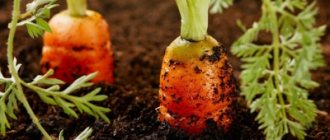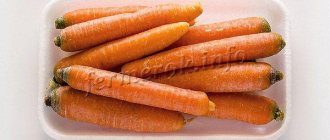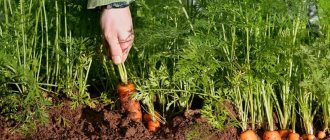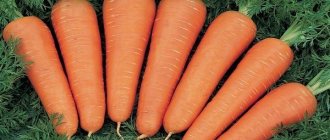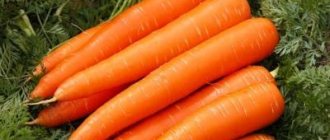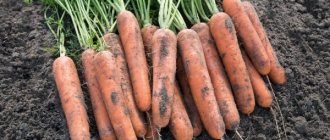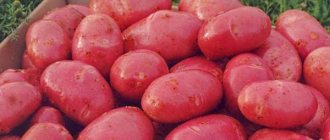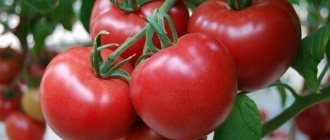Landing technology
Cordoba f1 carrot seeds have good germination, but when sowing them in the soil, it is recommended to follow several rules.
First of all, you need to select a suitable area for growing the crop and prepare the soil on it in order to create comfortable conditions for the plants to grow. At the same time, you need to take into account the rules of crop rotation in order to achieve high yields
Did you know? The fruits of wild carrots originally grew in Afghanistan and were purple in color. The orange color of vegetables arose as a result of selective breeding.
The procedure for planting Cordoba f1 carrot seeds in the soil does not have any specific features, but must be carried out strictly according to the instructions. Plants are usually placed on the site in rows, between which you need to leave at least 15–20 cm of free space. In this case, planting material is immersed in longitudinal furrows, placing adjacent seeds at a distance of 2 cm from each other.
Site selection and soil preparation
When choosing a site for growing this crop, you need to take into account its location, degree of illumination and soil composition. All these factors affect seed germination and yield rates, as well as the size and taste of ripe vegetables. A plot for growing Cordoba f1 carrots must meet the following requirements:
- loose and nutritious soil - ensures rapid germination of seeds and the formation of beautifully shaped fruits;
- flat surface of the site - if there are lowlands or holes, rainwater can accumulate in them, which will lead to rotting of root crops;
- soil acidity level is neutral or slightly acidic;
- good sunlight - in the shade the crop of this variety will grow much slower, and the root crops will not reach large sizes;
- the groundwater level is no closer than 60–80 cm from the soil surface - with excess moisture, the underground part of the plant can rot, and the root crops take on an ugly shape.
Find out what kind of soil carrots like and how to prepare it for planting.
Before sowing seeds, it is necessary to prepare the soil in the selected area. To do this, perform the following actions:
- after harvesting, the soil is cleared of weeds and all plant debris;
- in the fall, dig up the ground to a depth of about 30 cm, adding sawdust and peat to the soil (about 3 kg of mixture per 1 m²);
- in the spring, the soil surface should be loosened well and for every 1 m² of area, add half a bucket of humus, 2 tbsp. l. superphosphate, 1 tsp. saltpeter and 0.5 liters of wood ash.
Crop rotation rules
To maintain high yields, carrots of this variety are not recommended to be planted in the same place for two years in a row. It is best to grow this crop in the area where suitable predecessors grew before.
Experienced gardeners advise planting Cordoba f1 carrots after the following crops:
- zucchini;
- potato;
- cabbage;
- cucumbers;
- tomatoes;
- onion.
Legumes, dill, celery and parsley are considered bad predecessors for plants of this variety.
Important! You can grow carrots again in the same place only after 3-4 years.
Direct landing
Planting Cordoba f1 carrot seeds in an open area usually begins in the second half of April, but for the northern regions the sowing dates are shifted to the beginning of May. You need to focus on weather conditions - the seeds of this crop germinate best at a temperature of +15...+18 °C.
Step-by-step instructions for sowing Cordoba f1 carrots are presented below:
- Immerse the planting material in a glass of water for a few minutes. Floating seeds must be removed - they will not sprout after planting in the ground.
- Before planting, soak the selected seeds in a container of water for 48 hours so that they swell well. Then put them on a napkin and dry them a little.
- In the prepared area, draw long furrows 2.5–3 cm deep. If the ground is too dry, you can water the depressions a little.
- Place the seeds at the bottom of the furrow, keeping a distance of at least 2 cm between them. Sprinkle the planted material with loose soil.
- Lightly spray the surface of the bed with water and cover with film to provide the seeds with warmth and high air humidity. In such conditions, the first shoots appear in 10–12 days. After this, the cover can be removed.
The best mid-season carrot varieties with photos
If we talk about a mid-season vegetable, its ripening period begins at 90-120 days. Seed material is placed in the soil closer to mid-May or early June. If there is enough precipitation, then it is not necessary to moisten the soil before planting. In dry springs, pre-sowing watering is required.
The best medium varieties of carrots:
- Boltex. An even cone shape, short, weighty root vegetables (over 300 g each) and excellent taste - this is what distinguishes Boltex carrots. The description of the variety shows how productive this variety of vegetable is, because up to 8 kg can be harvested from one square. At the same time, it is achieved on all types of soils, especially on heavy chernozems and loams. The root crop can also be grown in unprotected beds and in a greenhouse. It is Boltex that is loved by many children. It is readily used by chefs and housewives to prepare delicious dishes. The fruits are stored well. Under certain conditions, they can last until mid-winter.
- Chance. Most gardeners recognize this mid-season carrot by its bright orange-red color. Chance (reviews say) is most loved by housewives, because it is used for salads, preserves and in the everyday preparation of favorite foods. Chance's pulp is very juicy. The average period of formation and ripening of a vegetable is 110 days. The weight of root crops can reach 180 g. The best place for growing is fertile black soil and sandy loam soils.
- Samson. Great choice. You can enjoy the excellent taste of sweet root vegetables approximately three and a half months after the seeds germinate and thin sprouts appear. Among this category, it is one of the earliest ripening. Therefore, residents of the Middle Zone choose this particular carrot. The Samson variety (see photo) is characterized by large fruits. Their length can reach 24 cm. The diameter at the base of the root crop can be about 6 cm. The shape is cylindrical. A characteristic feature is that it has an internal, pronounced core. What else can you say about Samson carrots? The description of the variety shows how productive the vegetable is, because summer residents harvest just under 8 kg from a square of garden bed. To achieve such indicators, it is recommended to choose light soil (sandy loam or light loam).
- Karotel. Refers to the short-stemmed type of root crops. It is no more than 12 cm long. At the same time, the yield is quite decent. What else makes Karotel carrots stand out? The description of the variety also speaks of unsurpassed soft, tender and juicy pulp. A characteristic feature of the vegetable is several tails at the tip. Insignificant eyes and tubercles are visible on the surface of the fruit. There is also a variety of this root vegetable - the Carotel Paris carrot variety. It is also often grown by many vegetable growers.
- Incomparable. The name of this carrot variety – Incomparable – speaks for itself. It is indeed difficult to compare it with any other mid-season variety. She is rightfully considered the queen of the vegetable garden. And not only for its long, weighty fruits, but also for its resistance to drought and many diseases. The average period after which you can get a wonderful harvest is 125-135 days. It is often suitable for those people who grow carrots for sale. She has a very good commercial appearance. In terms of weight, Incomparable is not inferior to the most productive types of vegetables. You can sow the seeds of this carrot before winter.
- Vitamin 6. Among many other mid-season varieties, this is the earliest. You can harvest your favorite vegetable in just three months. The root vegetables are long and thin, and they are also very tasty! Despite this, the pulp is very juicy. These carrots are suitable for making juices. It is eaten fresh. Housewives widely use it for various dishes. They don't last very long. What else makes vitamin carrots stand out? Description of the variety is standard. The only distinguishing property is a glossy, slightly tuberculate-striped surface. This factor contributes to the slight appearance of microcracks on the surface of the root crop.
Carrot variety Cascade F1
There is no point in talking about the popularity and usefulness of carrots. This vegetable is well known. It is grown everywhere and used in various areas of our lives. Carrots are used not only for cooking, but also in medicine and even in cosmetology.
The popularity of the vegetable is confirmed by the variety of its varieties.
Cascade carrots also deserve attention. It has a number of advantages over its relatives, therefore it is actively used for cultivation in personal plots and on an industrial scale.
Description of the variety
Carrots "Cascade F1" belong to the first generation hybrid varieties. It came to our region from abroad, but despite this it has taken root well and gained great popularity because it is perfect for growing in our climatic conditions. It tolerates temperature changes favorably, and has also shown high resistance to various diseases.
Cascade is planted with seeds in open ground. Loose, fertile soil is best suited for growing. Ideal predecessors are potatoes, onions, tomatoes, cabbage, legumes and melons.
When planting, beds are prepared, on which sowing rows are made at a distance of fifteen centimeters from each other. Seeds should be placed at a distance of four centimeters. The planting depth is no more than two centimeters.
In the case where sowing was done without taking these requirements into account, it is recommended to thin out the young seedlings, otherwise there is no point in expecting a good harvest.
Root crops ripen one hundred to one hundred and thirty days after sowing the seeds.
Of course, carrots should be looked after. The beds must be cleared of weeds and the soil loosened, thereby ensuring access of oxygen to the roots. The vegetable also needs regular watering. Compliance with these minimum requirements when growing allows you to harvest up to seven kilograms of crop from one square meter, which is a good indicator.
Cascade carrots have excellent taste. The root vegetable is bright orange, quite juicy and sweet. Therefore, it is good fresh, children love it. Carrots are used to make salads, juices, and food for children. In addition to taste, the vegetable has a number of useful qualities. It contains many useful vitamins and about eleven percent in one root vegetable. This means that to replenish the daily dose of this element, a person only needs to eat one carrot per day.
The vegetable also contains microelements such as potassium, calcium, phosphorus, chlorine, magnesium, iron, chlorine and others.
The appearance of carrots is also attractive to gardeners. It has a conical shape without cracks or bumps. The length of the root crop reaches up to twenty-two centimeters, diameter up to five.
Some growing tricks
Despite the fact that the variety provides for obtaining a beautifully shaped and tasty vegetable, when growing it it is still worth making some efforts to achieve maximum results.
And so, it is best to plant carrots in loamy, fertile soil with good drainage. To do this, chernozem is mixed with peat and compost. A slight increase in soil acidity will only benefit the root crop.
In addition, it should be noted that carrots do not like fertilization with fresh manure. Nitrogen imparts bitterness to the taste and affects the appearance of the vegetable; it may become covered with cracks, the surface becomes rough, with tubercles.
Water the beds regularly, and then be sure to fluff up the soil. When active root formation occurs, fertilizer is applied in the form of a weak solution of superphosphate.
As you can see, there are no difficulties in growing vegetables. Therefore, “Cascade” carrots are an excellent variety for home gardens, which require minimal costs, but at the same time please with a rich harvest.
Characteristics Cascade F1 - carrots, (fraction 1.6-1.8), (precision seeds), Bejo Holland
Carrot Cascade F1 (Kaskad F1) Bejo (Bejo), Holland: This hybrid was released thanks to scientists from the Bejo company, founded in 1899 in Holland, specializing in the breeding of new plant varieties and their processing.
Characteristics of carrots Cascade F1 (Kaskad F1): A hybrid plant suitable for most climate zones. The root crop develops smoothly and colors very quickly. The period from mass germination to technical maturity of the root crop averages from 94 to 125 days. Type of root vegetable - Shantane. Cascade carrots are an early-ripening hybrid plant. Like all plants of the “Chantane” variety, carrots are formed into a cone shape. The average length of the root crop ranges from 12 to 16 centimeters, the diameter of carrots is up to 6 centimeters. The tip of the root is blunt, the core is large. The carrot flesh is bright. The root vegetable has a sweet, not cloying taste. The fruit contains 10.9% dry matter, 7.6% sugar. A very large yield of juice from root vegetables, more than half a kilogram from one kilogram of root vegetables. The hybrid has excellent immunity to flowering, even in extremely unfavorable conditions, in the cold - the plant is not susceptible to this disease. The ovary of the root crop occurs very quickly. By planting this hybrid you can get a crop with very high marketability. The hybrid also shows very high shelf life and is suitable for long-term storage. Carrots tolerate mechanical harvesting well. The manufacturer guarantees an excellent harvest subject to the agrotechnical process and normal thickening when planting from 700 thousand to 1 million 200 thousand plants per hectare of sown area.
Additional information: The plant shows excellent growth results when planted on loose, warm soils with an acid-base balance index of 5.6 - 6.9. Hybrid requires the best lighting. Preparations for planting in open ground are made in the second half of April. Planting a hybrid after legumes, carrots and parsley is highly undesirable. It is favorable to plant the plant after potatoes, cabbage, zucchini, onions, cucumbers and tomatoes. Caring for a carrot plant is not difficult, and often includes timely watering, fertilizing, weeding and thinning of seedlings. Carrots are a stress-tolerant plant, so watering carrot plants should only be done during dry times. An optimal water consumption of about five liters per square meter of planting is recommended.
We offer to buy carrot hybrid seeds Kaskad F1 from us:
The Farmer Center company is the official store selling seeds from Bejo, Holland. We sell only original and certified seeds with proper expiration dates. Each delivery of goods is accompanied by a quality certificate. You can buy seeds with delivery throughout Russia, Ukraine, Kazakhstan and Belarus. We provide express delivery to Rostov-on-Don, Volgograd, Stavropol, Astrakhan, Moscow, Krasnodar, Saratov, Kiev, Dnepropetrovsk, Almaty, Donetsk, Cherkessk, Maykop, Vladikavkaz, Nalchik, Derbent, Slavyansk in Kuban, Penza, Lipetsk, Voronezh, Nalchik and other cities. It is profitable to buy with us.
https://fermilon.ru/sad-i-ogorod/ovoshhi/morkov-kaskad-f1.html
https://optsemena.ru/kaskad-f1-morkov-frakciya-1-6-1-8-1-000-000-semyan-bejo-hollandiya
Carrot Cascade F1
Carrot variety Cascade F1
There is no point in talking about the popularity and usefulness of carrots. This vegetable is well known. It is grown everywhere and used in various areas of our lives. Carrots are used not only for cooking, but also in medicine and even in cosmetology.
The popularity of the vegetable is confirmed by the variety of its varieties.
Cascade carrots also deserve attention. It has a number of advantages over its relatives, therefore it is actively used for cultivation in personal plots and on an industrial scale.
Description of the variety
Carrots "Cascade F1" belong to the first generation hybrid varieties. It came to our region from abroad, but despite this it has taken root well and gained great popularity because it is perfect for growing in our climatic conditions. It tolerates temperature changes favorably, and has also shown high resistance to various diseases.
Cascade is planted with seeds in open ground. Loose, fertile soil is best suited for growing. Ideal predecessors are potatoes, onions, tomatoes, cabbage, legumes and melons.
When planting, beds are prepared, on which sowing rows are made at a distance of fifteen centimeters from each other. Seeds should be placed at a distance of four centimeters. The planting depth is no more than two centimeters.
In the case where sowing was done without taking these requirements into account, it is recommended to thin out the young seedlings, otherwise there is no point in expecting a good harvest.
Root crops ripen one hundred to one hundred and thirty days after sowing the seeds.
Of course, carrots should be looked after. The beds must be cleared of weeds and the soil loosened, thereby ensuring access of oxygen to the roots. The vegetable also needs regular watering. Compliance with these minimum requirements when growing allows you to harvest up to seven kilograms of crop from one square meter, which is a good indicator.
Cascade carrots have excellent taste. The root vegetable is bright orange, quite juicy and sweet. Therefore, it is good fresh, children love it. Carrots are used to make salads, juices, and food for children. In addition to taste, the vegetable has a number of useful qualities. It contains many useful vitamins and about eleven percent in one root vegetable. This means that to replenish the daily dose of this element, a person only needs to eat one carrot per day.
The vegetable also contains microelements such as potassium, calcium, phosphorus, chlorine, magnesium, iron, chlorine and others.
The appearance of carrots is also attractive to gardeners. It has a conical shape without cracks or bumps. The length of the root crop reaches up to twenty-two centimeters, diameter up to five.
Some growing tricks
Despite the fact that the variety provides for obtaining a beautifully shaped and tasty vegetable, when growing it it is still worth making some efforts to achieve maximum results.
And so, it is best to plant carrots in loamy, fertile soil with good drainage. To do this, chernozem is mixed with peat and compost. A slight increase in soil acidity will only benefit the root crop.
In addition, it should be noted that carrots do not like fertilization with fresh manure. Nitrogen imparts bitterness to the taste and affects the appearance of the vegetable; it may become covered with cracks, the surface becomes rough, with tubercles.
Water the beds regularly, and then be sure to fluff up the soil. When active root formation occurs, fertilizer is applied in the form of a weak solution of superphosphate.
As you can see, there are no difficulties in growing vegetables. Therefore, “Cascade” carrots are an excellent variety for home gardens, which require minimal costs, but at the same time please with a rich harvest.
Carrot Cascade F1
Carrots are a unique vegetable crop. It is used not only in cooking, but also in cosmetology and medicine. The root vegetable is especially loved by fans of dietary, healthy eating. In domestic latitudes it can be found in almost every garden. Beginners and experienced farmers select the best varieties of this vegetable from a wide variety. These include carrots “Cascade F1”. You can see the root crop of this variety and learn about its taste and agrotechnical characteristics below.
External description and taste of the root vegetable
Carrots of the “Cascade F1” variety contain a significant amount of carotene and sugar. This composition affects the taste and external qualities of the root vegetable: the bright orange pulp is exceptionally juicy and sweet. The sweet vegetable is widely used for preparing fresh salads, vitamin juices, and baby food.
Features of sowing and caring for plantings
To obtain high yields of orange root crops, you must follow the simple rules of agricultural technology for this crop. To plant a vegetable, you should select a suitable area and prepare the seed material for sowing, and after the plants have sprouted, properly care for them.
Dates and place
Check out the features and rules for sowing carrots in open ground
To collect early root crops, winter sowing is practiced. However, this method cannot be used in areas with severe winters or thaws, after which frosts return.
Therefore, preference is usually given to spring planting, when frost is no longer expected.
If carrots are needed for winter storage, then sowing is recommended on days when the daytime temperature is +15...+18°C. The soil should have time to warm up to +5…+7°С.
Soil acidity and crop rotation
Carrots prefer to grow on neutral (6–7 pH) sandy loam, loamy and peaty soil. You should not plant this vegetable where carrots themselves, as well as parsley, parsnips, dill and beans, previously grew. It’s good if this crop was preceded by potatoes, cucumbers, zucchini, cabbage, tomatoes, garlic and onions.
In spring, the area should be leveled using a rake. The area for planting should be prepared in the fall and fertilizer should be added while digging the beds. In this case, per 1 m² you need to take 30 g of superphosphate, 15 g of potassium, 20 g of nitrogen and 2–3 kg of humus. If the soil in the future carrot bed has high acidity, it should be limed.
Important! To reduce acidity, you need to add ash and dolomite flour to the ground.
How to prepare seeds for planting
Seed material requires preparation before planting in order to improve its germination and protect against the appearance of certain diseases.
As a rule, 4 seed treatment methods are used:
- Place the seed material for 1 day in water at a temperature of about +30°C. Change the water at least 6 times.
- Use ash solution. To do this, add 1 tbsp to warm water. spoon of ash and wet the seeds. Then rinse the seeds with clean water, wrap them in a piece of cloth and place them on the refrigerator shelf, where they should be kept for 2 days.
- Pour the seeds into a cotton bag and dip into water heated to 50°C, and after 2-3 minutes transfer to cold water to cool.
- Bubble the seeds (if you have a bubbler). To do this, place them for 20 hours in a solution of Epin or Silk preparations with oxygen saturation.
The germination of seeds of the Cascade variety is good. Therefore, in order to avoid thinning the beds and save seeds, you can plant them on adhesive tape at a distance of 2–3 cm from each other.
Watering and loosening the soil
To obtain a rich harvest of orange root vegetables, you need to organize proper watering of the carrot bed. During irrigation, the soil should be moistened to a depth of 0.3 m. The next day after watering, it is recommended to loosen the soil and at the same time remove weeds.
Read more about How to properly water carrots in August in open ground and greenhouses
Excessive moisture is also unacceptable, since the root crops begin to crack, become covered with small shoots, and the tops grow too much.
Basically, carrots are irrigated once every 7 days. Initially, watering is carried out based on the proportion of 3 liters per 1 m². Then, after the second thinning, the watering volume reaches 10 liters. With active crop growth, the amount of moisture is increased to 20 liters.
1.5–2 months before harvesting, plantings are watered once every 10–14 days at the rate of 10 liters per 1 m². Watering should be stopped 2 weeks before harvesting root crops.
Fertilization and thinning
During the entire growing season of carrots of the Cascade variety, it is necessary to carry out 2 feedings:
- 21–28 days after emergence;
- 2 months after the previous application of fertilizers.
To feed, you need to make the following nutrient solution (for 1 bucket with a volume of 10 l):
- 1 tbsp. spoon of nitrophoska;
- 0.5 l of ash;
- 20 g of potassium nitrate;
- 15 g each of urea and double superphosphate.
Fertilizer application should be carried out together with the watering procedure. Thin out the plantings twice. This is done for the first time when the plant forms its third leaf. This usually occurs 3-4 weeks after planting the seeds. The process itself is carried out after abundant moistening of the beds. In this case, a gap of 2–2.5 cm is made between the plants. The second time, thinning is carried out 3 weeks after the first procedure. A distance of 4.5–5 cm is left between the root crops.
Important! It is better to thin carrots in the evening, since during the day the smell of the vegetable can attract pests. The torn plants should be moved away from the planting so that the aroma is not noticeable.
Description and characteristics of the variety
The Cascade carrot is a 1st generation hybrid and was developed in the Netherlands. In 2001, the variety was included in the State Register of the Russian Federation and zoned in the Central region.
Shape and size
Cascade is a carrot variety of Chantane. The vegetable has a semi-conical shape with a slightly pointed rounded end. The length of the root varies from 18 to 23 cm, and the diameter is 3–4 cm. The surface of the vegetable is smooth and leveled.
Taste qualities
Cascade carrots contain a lot of carotene (21 mg/100 g), which causes their intense orange color. The core of the root vegetable is also orange and small in size. Carrots taste sweet and juicy. It contains 8.2% sugars and 14.3% dry matter.
These carrots are good for fresh consumption, preparing salads and other dishes, for baby and dietary food. In addition, the orange vegetable is perfect for obtaining juice - 1 kg of root vegetables gives 0.5 liters of juice.
Productivity of the variety
The volume of carrot harvest depends on the type of soil and agricultural cultivation technology. The best yield of the variety is on loose soils, although it can show good yield on medium-heavy soils.
The highest harvest was obtained in the Vladimir region, where 709 centners of carrots were harvested from 1 hectare. On average, the yield of the variety is in the range of 4.5–7.5 c/ha. Cascade carrots can be harvested mechanically. Marketability of root crops is 93%.
Ripening time
This vegetable has a medium-late ripening period. Its harvest begins on the 120–130th day from the time of emergence. This is the technical maturity of the vegetable, and selective harvesting of individual root crops can be done as early as July.
Variety immunity to diseases
The Cascade variety has good immunity and performs well in different climatic conditions. It is resistant to fungal diseases - Alternaria, black rot, cercospora.
Growing carrots Solomon F1
Among late-ripening varieties, gardeners highlight Solomon f1 carrots. It gained popularity thanks to its large fruits. The crop is excellent for harvesting for the winter, has a good taste and presentable appearance.
Growing carrots Solomon F1
Characteristics of the variety
The yield of the Solomon hybrid is 229-416 kg per 1 ha. It is suitable for industrial cultivation.
Description of the bushes
The rosette of leaves is semi-spreading. The leaf blades are medium-sized, elongated, coarsely dissected. The color is dark green.
Description of fruits
The shape is cylindrical, the tip is slightly pointed. The fruits are leveled. The skin color is intense orange. The color inside is the same. The root vegetable is juicy and sweet. Suitable for fresh consumption, canning, freezing and growing for bunched products.
It has the following composition per 100 g of fresh product:
- dry matter - 12.3-15.7%;
- sugar - 7.2-8.7%;
- carotene - up to 16.4 mg.
According to the description, the Solomon f1 variety has the following positive qualities:
- high taste characteristics;
- yield of marketable products 68-91%;
- hearth size;
- excellent keeping quality: carrots are stored until the end of spring.
Growing
Growing is no different from other varieties
Planting time in the ground is May 7-8. Planting carrots later will result in slower plant development.
The best precursors for the crop are corn, cabbage, beets, and tomatoes. Carrots prefer light, loose, well-structured soil. It has been prepared since autumn. The acidity should be neutral or weak. High pH levels are neutralized by adding lime to the soil (300-400 g per 1 sq. m). To improve the soil, sand and humus are added to it (3-4 kg per 1 sq. m). The root crop does not accept fresh manure. In spring, the soil is loosened with a rake.
To increase the germination of seeds, they are prepared before planting. To do this, the following procedures are performed:
- Disinfection. The grains are placed in a solution of potassium permanganate for 15-20 minutes, then removed and washed.
- Warming up. The seed is soaked in warm water (50°C) for 20 minutes.
- Nutrient saturation. The seeds are treated with growth stimulants. They are placed in a solution of the drug “Epin” for a day.
Disembarkation
The bed must be moist. Carrots of the Solomon f1 variety are planted in furrows, which are made at a distance of 18-20 cm. The seeds are distributed evenly. Their planting depth is 0.5-2 cm, depending on the soil. Seeding rate - 0.4-0.6 g per 1 square. m. The grains are sprinkled with earth and lightly compacted. Watering is carried out using the sprinkling method.
About 2 weeks after germination, when 1-2 leaves appear, the carrots are thinned out. The second thinning is carried out 3 weeks after the previous one. Plants respond well to loosening the soil. At the same time, weeding is carried out.
Fertilizer
Fertilizers are applied by the root method after abundant watering. Nitrogen-containing products are used to grow tops. In the 3-sheet phase, use ammonium nitrate (30 g per 10 liters of water) or organic matter:
- infusion of bird droppings;
- slurry;
- fermented infusion of nettles and weeds.
Then the plants are provided with potassium and phosphorus.
Watering
Both excess and lack of water are harmful to the culture. In hot weather, plants are watered every 4-5 days. In rainy weather, excess liquid is drained from the beds. Before emergence and when the plants are small, the soil is kept constantly moist. When the root crop reaches normal size, stop watering. To retain water, the ground is mulched.
Diseases and pests
Preventing carrots from becoming infected
Carrots are affected by various fungal diseases:
- anthracnose;
- gray rot;
- brown spot;
- Phomasis;
- cercosporiosis.
To combat diseases, systemic fungicides are used. Plants are treated with Oksikhom, Fundazol, Falcon or 1% Bordeaux mixture. Affected root crops are pulled out.
Various insects can also harm the crop:
An infusion of tobacco and onion peel also helps well. Dust with ash or ground black pepper.
To prevent diseases, the following preventive measures are taken:
- observe crop rotation;
- disinfect seeds;
- provide the plantings with proper care;
- collect plant residues from the garden beds;
- treat vegetables with 1% Bordeaux mixture.
Recommended varieties
Below is a brief description of the carrot varieties with photographs mentioned in this article.
"Berlicum Royal" Late-ripening variety; intended for winter storage. It is resistant to fungal diseases. The root crops are cylindrical, long, large (weighing up to 190 g). The skin is dense, the pulp and core are orange.
"Berlicum Royal"
“Vitaminnaya 6” Popular mid-season variety; It is cultivated in almost all climatic zones of Russia. Used fresh and in the preparation of canned food. The root crops are blunt-ended, cylindrical, medium-sized (up to 165 g). The pulp is orange, excellent taste.
"Vitamin 6"
“Granddaughter” An early ripening variety, recommended primarily for obtaining the first vitamin products. The root vegetables are short, oval in shape, with uniform dark orange pulp. Has excellent taste characteristics. Suitable for growing in small volumes of soil (in balcony boxes or pots).
"Granddaughter"
Hybrid "Belgrado F1" Medium late. Suitable for winter storage, raw consumption and culinary purposes. It can be successfully cultivated in almost any climatic zone of our country. The root vegetables are long, large (up to 220 g), orange, and have excellent taste.
Belgrade F1
Hybrid "Calgary F1" Mid-season hybrid for universal use. Root crops up to 23 cm long, weighing up to 165 g, conical, bright orange. The pulp is sweet, juicy, tasty. The plant is resistant to fungal diseases and carrot fly damage.
"Calgary F1"
Hybrid "Canada F1" Reliable, mid-late hybrid for cultivation throughout Russia. The widest intended use is recommended: from fresh consumption to canning and winter storage. Root vegetables with orange colored flesh, long, conical, weighing up to 170 g.
You can find out more information about the variety from this article.
"Canada F1"
Hybrid "Cascade F1" Late-ripening, high-yielding hybrid, suitable for growing in any climatic zone. The root crops are spindle-shaped, short, weighing from 110 to 215 g. The color is orange, the taste is excellent.
"Cascade F1"
Hybrid "Naval F1" Mid-season hybrid for cultivation in almost all climatic zones of the country. The purpose is universal. The root vegetables are orange, cylindrical, weighing up to 250 g. The taste is excellent.
"Naval F1"
Hybrid "Natalia F1" Mid-early hybrid. Well suited for canning in salads, freezing and eating fresh. Suitable for cultivation in not very favorable climatic conditions (including in the Northern, Northwestern and Western Siberian regions), as well as on heavy soils. The root vegetables are cylindrical in shape, small (weighing up to 110 g), with uniform orange pulp of excellent taste.
"Natalia F1"
Hybrid "Niagara F1" Mid-season hybrid, universal purpose. Recommended for cultivation in most climatic zones of the country (except for the southern regions). The root crop is cylindrical of medium length, weighing from 90 to 220 g, orange, with high taste characteristics.
"Niagara F1"
“Children's Joy” Mid-season variety. Suitable for fresh consumption, canning and freezing. If optimal conditions are met, it can be stored in winter. Root vegetables are conical in shape, medium in size (weighing no more than 160 g), which are distinguished by their juiciness, excellent taste, high content of vitamins and natural sugars.
"Children's Joy"
“Dobrynya” A late-ripening variety intended for winter storage and canning. The root vegetables are conical, medium in size (weight up to 150 g), with uniform orange pulp. Recommended for cultivation in the Central region, well suited for the conditions of the Moscow region.
"Dobrynya"
"Emperor" One of the best hybrids for private farms in the Central region. Late ripening. The root crops are cylindrical, long, bright red, weighing up to 190 g. The crop is well stored; recommended for universal use.
"Emperor"
"Beauty Maiden" Mid-season hybrid of universal use. Recommended for cultivation in the Central region. The root vegetables are orange, medium in size (weight up to 160 g), with a high content of sugars and biologically active substances. An excellent product for dietary and baby food.
"Beauty maiden"
"Longe Rote" Mid-season variety. Suitable for fresh consumption and canning. Plants obtained by late thinning of seedlings can be used as “bundle” vitamin products. The roots are cylindrical, long, weighing up to 185 g. The pulp is dark orange, of excellent taste. One of the “coreless” varieties, ideal for processing.
"Longe Rothe"
“Losinoostrovskaya 13” A proven, widespread, productive mid-season variety. Cultivated throughout Russia. Root vegetables are medium-sized (weight up to 170 g), cylindrical, orange in color. The pulp is juicy and sweet. The purpose is universal. Seeds and seedlings tolerate temperature fluctuations well, so the variety is often used for winter sowing.
"Losinoostrovskaya 13"
“Monastyrskaya” Late-ripening variety of the widest purpose. Recommended for cultivation in the Central region. Root vegetables are orange, long, of medium weight (up to 150 g). Taste qualities are highly rated.
"Monastyrskaya"
“Moscow Winter A 515” A consistently productive mid-season variety, recommended for fresh consumption, canning and storage. Root vegetables are medium-sized (up to 170 g), conical, orange. The pulp is juicy, sweet, tasty. The variety is suitable for winter sowing, provided that winter root crops are used exclusively for immediate consumption.
"Moscow Winter A 515"
“Nantes 4” Mid-season variety. Cultivated throughout Russia. Intended for fresh consumption and processing. The root vegetables are cylindrical, convenient, medium in size, beautiful orange in color. The pulp is juicy and sweet, good for making purees and juice. The variety is resistant to soaking and freezing of seeds, suitable for both spring and winter sowing.
You can find out more detailed information about the variety from this article.
"Nantes 4"
“Nastena” is a mid-season variety, mainly for the Central region. Universal use. Root vegetables of good taste, orange, cylindrical, weighing up to 150 g.
"Nastena"
“Incomparable” Widespread mid-season variety for universal use. The root vegetables are cylindrical, weighing up to 200 g. The pulp is bright orange, juicy, of good taste. The variety is resistant to fungal diseases.
"Incomparable"
"NIIOKH 336" Mid-season variety, suitable for almost any climatic zone of Russia. The purpose is universal. The root vegetables are cylindrical, medium in size up to (130 g), bright orange in color. The pulp is evenly colored, juicy, with a high carotene content.
"NIIOKH 336"
“Autumn King” A mid-late variety mainly for the Central climatic zone. The root crops are spindle-shaped, of medium length, weighing from 100 to 250 g. The pulp is dense, orange. One of the best varieties for winter storage.
"Autumn King"
“First harvest” A high-yielding mid-early variety that produces high-quality vitamin products for fresh consumption. Root vegetables weighing up to 130 g, conical, elongated, orange in color, juicy and tasty.
"First gathering"
“Early TSHA” One of the earliest ripening varieties. It is cultivated exclusively for the production of vitamin “bunch” products, which are used fresh. The root vegetables are small (weighing up to 90 g), light orange, cylindrical, with a pleasantly sweet, refreshing taste.
"Early TSHA"
“Rogneda” The variety is recommended for cultivation throughout the country. Mid-season, universal purpose. The root vegetables are small, smooth, weighing 90-100 g. The pulp is orange, the taste is excellent. One of the most productive and low maintenance varieties.
"Rogneda"
"Rote Riesen" Late-ripening variety for canning and long-term winter storage. Cultivated mainly in the Central region. The root vegetables are cone-shaped, orange, medium-sized (up to 130 g). They are distinguished by their high carotene content and good taste.
"Rote Riesen"
“Sophie” “Toy” carrots with spherical root crops, well suited for “balcony” gardening. The variety is early ripening. Root vegetables weighing up to 115 g, dark orange, juicy, sweet, very tasty. These vegetables are good to grow with children, who will be happy to treat themselves to a self-grown crop.
"Sophie"
“Tushon” One of the most successful mid-season varieties for growing in the Central region. The purpose is universal. The root vegetables are cylindrical, medium-sized (weight up to 170 g), orange, tasty, juicy, with a high carotene content.
"Touchon"
"Flaccoro" One of the most worthy late-ripening varieties of Dutch selection. Universal purpose; Perfect for winter storage. The root crops are quite large (up to 200 g), conical, bright orange in color. The pulp is dense, with a high content of carotene and sugars. The variety is resistant to fungal diseases.
"Flaccoro"
"Chantenay 2461" Mid-season variety, universal purpose. Recommended for cultivation throughout Russia. The roots are short (up to 15 cm), conical in shape with blunt tips. The pulp is dense, orange in color, the core is almost invisible. The variety is characterized by high yield and saturation with useful substances.
"Chantenay 2461"
“Yaroslavna” An early ripening variety intended for growing the first vitamin products. The root vegetables are spindle-shaped, long, orange, weighing 80-110 g. The taste is delicate, refreshing, sweet.
"Yaroslavna"
Description of the features of growing carrots Canada F1
This variety demonstrates good results on different soils (even those where other varieties do not grow), but produces the greatest yield on slightly acidic sandy and light loams. He doesn't need intense lighting. The most favorable predecessors are tomatoes, potatoes or onions. Hybrid Canada does not like too dense sowing, so the optimal quantity is 90-100 pcs. seeds per 1 sq. m.
Sowing occurs quite early - at the turn of April and May. This is due to the fact that the seeds germinate slowly. If the material is not from a store, it must be pre-soaked in order to sort out low-quality specimens. Seed germination will speed up germination by a few days. In addition, you can treat the seed with a growth stimulator.
The soil in the garden bed should be loose, fertilized with organic matter:
- Before sowing, lightly water the soil.
- Make grooves up to 2 cm deep.
- Place one seed at a time into the furrows, keeping a distance of 0.5 cm. The gaps between the rows are 0.2 m.
- Mulch the row with peat.
- Cover with film.
Carrots Canada
The polyethylene can be removed when the shoots hatch. 2 weeks after this, do the first thinning. You should leave 1-2 cm between sprouts. Carrots need to repeat the procedure after 4-5 leaves appear in the rosette. This time leave 4-6 cm between plants.
Secrets of growing delicious carrots
The “Cascade F1” variety at the genetic level provides for the formation of smooth and very tasty root crops. However, in order to get a rich harvest of beautiful carrots, the gardener needs to make some efforts and adhere to certain rules. So, when cultivating root crops, it would be useful to know the following points:
- The ideal soil for carrots is fertile loam with good drainage. To create such soil, it is recommended to mix garden soil, compost, sand, and peat. In heavy soils (clay), sawdust should be added in the amount of 1 bucket per 1 m2 of soil. The sawdust must first be soaked in a urea solution.
- The root crop prefers soils with a slightly higher pH value.
- Excessive saturation of the soil with nitrogen leads to the appearance of bitterness in taste, the formation of many small roots, and cracks on the surface of the vegetable. Therefore, it is impossible to apply fresh manure to carrot crops.
- Watering carrots should be done regularly. In this case, the depth of soil saturation should be no less than the length of the root crop.
- To fertilize the crop during the period of active growth, watering with a weak solution of superphosphate should be provided.
- Thinning carrots will avoid deformed fruits. The first stage of thinning should be provided 2-3 weeks after emergence.
Additional information about the rules for growing delicious carrots can be found in the video:
Features of cultivation
The Cascade variety is planted using seedlings. This allows you to grow a full-fledged harvest even in regions with short and cool summers. Tomatoes are grown according to a clearly described scheme, taking into account all the nuances. Main stages:
- Time for sowing seeds. The Cascade variety is sown in late February or early March. The exact date depends on the weather conditions of the current year in the region.
- Preparation of soil and containers. A soil mixture of peat with sand or turf (4:1) is well suited for tomato seedlings. The container should be taken in such a way that it can be conveniently placed indoors. Treat the soil and container with a solution of potassium permanganate.
- Preliminary preparation of planting material. Place the seeds in salted water (1 tablespoon of salt per 1 liter of water) and remove those that float. Then prepare a solution of potassium permanganate and immerse the seeds for 10 minutes. Rinse with clean water, dry on a napkin.
Important! All these procedures are easier to carry out using a bandage or gauze.
After completing the preparatory activities, you can begin sowing seeds of the Cascade variety for seedlings. Landing algorithm:
- Fill the containers with soil mixture and compact lightly.
- Make grooves 0.5-1.0 cm deep. Place the seeds and sprinkle with a little soil.
- Water the Cascade tomato crops using a spray bottle.
- Cover with film or glass and place in a warm place.
- Monitor soil moisture and remove condensation.
As soon as the tomato seeds germinate, remove the film and transfer the container to the light.
Water only with settled warm water from a pipette. After waiting for 2-3 true leaves, pick. Plant the seedlings in separate cups and leave them there until planting in a permanent place.
Picked seedlings develop much better
After 10 days, feed the Cascade seedlings with a solution of complex mineral fertilizer. A week before planting, start hardening the seedlings.
Prepare a bed where the bushes will be transplanted
To do this, it is important to adjust the acidity. The Cascade variety prefers a pH value of no more than 6.5
Add organic matter and dig with soil. Be sure to follow the rules of crop rotation.
Tomato seedlings should be planted when the threat of frost has passed.
Before planting seedlings in a permanent place, they need to be hardened off
Dig holes 5-7 cm deep. Planting pattern 0.4-1.2 m. The first value is the distance between the bushes, the second is for row spacing. For 1 sq. It is recommended to place no more than 3 plants in the greenhouse and 3-4 bushes in open beds.
Caring for the Cascade variety consists of:
- Dosed watering. Once a week, strictly at the root, with settled water is enough. Water young plants as the soil dries. More abundant moisture is required at the time of flowering and fruit formation. When pouring tomatoes, reduce watering slightly.
- Feeding. It is necessary to fertilize the Cascade bushes at least 3 times. It is necessary to alternate organic and mineral fertilizers. Tomatoes respond well to a solution of wood ash, mullein infusion or bird droppings. Complexes with potassium and phosphorus components should also be added, especially during flowering and harvest formation.
- Forming a bush. This is a must for tall tomatoes. It is recommended to keep the cascade in 1 main stem. You can leave 2 additional ones.
- Stepsoning. Another important procedure that increases the yield rate.
When growing in a greenhouse, you need to ventilate and monitor the level of air humidity.
Agricultural technology
"Cascade F1" is a first generation hybrid. This variety was obtained by breeders of the Dutch company Bejo. Despite foreign production, the crop is excellent for domestic conditions; it is successfully grown in the central and northwestern climatic zone of Russia. The variety is resistant to adverse weather conditions and a number of diseases.
To sow seeds, it is necessary to select an area with loose, fertile soil, on which melons, legumes, crops, cabbage, onions, tomatoes or potatoes previously grew. When forming rows, a distance of at least 15 cm should be provided between them. A distance of at least 4 cm should be provided between seeds located in the same row. It is recommended to plant seeds to a depth of 1-2 cm.
Read also: Furor grapes: variety description, planting and care
The period from the day of sowing the seeds of the “Cascade F1” variety to the day of harvesting is approximately 100-130 days. During the growing period, the vegetable must be watered and weeded abundantly. In the presence of favorable conditions, the yield of the variety is quite high - up to 7 kg/m2.
Harvest and storage
The Cordoba f1 carrot crop begins to ripen in August. The main sign of fruit maturity is the yellowing of the lower leaves of the tops and the rich orange color of the top of the root crop.
Important! Ripe carrots must be dug out of the ground immediately so that their flesh does not become sluggish and loose from being in the ground for a long time.
The basic rules for harvesting and storing root crops are listed below:
carrots are dug up in dry and sunny weather, before the start of the rainy season and cold weather; vegetables are dug up with a pitchfork and then carefully pulled out of the ground by the tops; the fruits must be carefully cleaned with your hands from adhering clods of earth, but they cannot be washed in water; The tops of the dug plant are cut off - using a knife, the leaves and about 3 mm of the top of the root crop are removed; To dry, the fruits are laid out in a small layer in the shade outside or in a well-ventilated area for several hours; Before storing, the fruits are sorted, removing specimens damaged by rot or pests; vegetables are stored in a dark basement with good ventilation at a temperature of 0...+2 ° C and air humidity of 90–95%.
Pest, disease and weed control
Carrots can be affected by various diseases and can also be attacked by insect pests. Therefore, it is important to know what measures should be taken when a particular problem arises.
Diseases such as bacteriosis, septoria, phomosis and rot can significantly reduce yields. Infection with bacteriosis occurs through infected seeds or plant debris. Therefore, seed material should be disinfected before planting, and tops and other vegetation should be removed from the beds. The Tigama solution is well suited for disinfection.
Signs of septoria are small chlorotic spots on the leaves of the root crop, which after some time become brown. High humidity promotes the rapid spread of the disease.
To combat septoria, treatments are carried out with 1% Bordeaux mixture with an interval of 10–12 days. Severely affected specimens must be pulled out and disposed of.
Rot (gray, white, red, black) appears during storage. To eliminate the disease, soil with a high level of acidity should be limed, nitrogen-containing fertilizers should be added, and carrot plantings should be regularly cleaned of weeds.
Before storing vegetables, they should be sprinkled with chalk. It is imperative to follow the rules for storing these root vegetables. Red rot is detected in the form of brown spots on carrots, in place of which black sclerotia of the fungus appear over time.
The disease can be provoked by manure, which is used as fertilizer. Black rot can be detected by dark, rotten areas on the vegetable. Diseased specimens should be pulled out.
Carrots are also susceptible to attack by pests such as carrot flies, fall armyworms, wireworms and slugs. You can collect slugs by hand if there are only a few of them. It is also good to use traps: cans of beer are buried in the ground for this purpose.
To combat insect pests, insecticidal preparations such as Anometrine, Revikurt, and Etafos are used. To repel arthropods, you can also plant onions, garlic, marigolds or marigolds between the rows.
Description of the variety Canada F1
The hybrid has gained popularity in the Russian Federation due to landowners from non-black earth regions. Canada is a fairly resilient and well-established carrot. At the same time, root vegetables are not inferior in taste and appearance to the best heat-loving varieties:
- shape – classic carrot cone with a pointed end;
- length – 18-20 cm, cross-section – 5 cm;
- weight - on average 130-170 g, maximum - 500 g;
- peel – smooth, without bumps;
- pulp – bright orange;
- the core is small, slightly richer in color;
- taste – sweet, juicy.
Canada F1 is a mid-late variety. Harvest ripening period is about 4 months. from the emergence of seedlings. The leaves are dark green in color, without pubescence. The average hybrid yield balances between 4.5 and 7.6 kg/sq. m. According to reviews, carrots give a good harvest even in heavy clay soil. Despite the late planting time, it often outstrips other varieties in growth.
Advantages of the Canada F1 hybrid:
- excellent presentation and pleasant taste;
- abundant yield;
- long storage period;
Carrot seeds Canada
- resistance to diseases: cercospora, Alternaria, flowering;
- high carotene content;
- unpretentiousness to the type and composition of the soil.
Attention! Carrots Canada F1 proves excellent preservation even in the simplest conditions. For example, it does not spoil all winter in a regular tank under film.
Carrot Cascade F1
Carrots are a unique vegetable crop. It is used not only in cooking, but also in cosmetology and medicine. The root vegetable is especially loved by fans of dietary, healthy eating. In domestic latitudes it can be found in almost every garden. Beginners and experienced farmers select the best varieties of this vegetable from a wide variety. These include carrots “Cascade F1”. You can see the root crop of this variety and learn about its taste and agrotechnical characteristics below.
External description and taste of the root vegetable
Carrots of the “Cascade F1” variety contain a significant amount of carotene and sugar. This composition affects the taste and external qualities of the root vegetable: the bright orange pulp is exceptionally juicy and sweet. The sweet vegetable is widely used for preparing fresh salads, vitamin juices, and baby food.
To obtain the required daily dose of carotene, it is enough to consume 1 carrot of this variety per day.
In addition to carotene, carrots are rich in other beneficial microelements. Thus, it contains potassium, calcium, phosphorus, chlorine, iron, magnesium, vitamins B, PP, K, C, E.
For connoisseurs of aesthetic qualities, the “Cascade F1” variety is a godsend:
- the shape of the root crop is conical;
- transverse diameter 3-5 cm;
- length up to 22 cm;
- weight at 50-80 g;
- no cracks or bumps.
This ideal description is confirmed by reviews from gardeners and photos of the vegetable.
Agricultural technology
"Cascade F1" is a first generation hybrid. This variety was obtained by breeders of the Dutch company Bejo. Despite foreign production, the crop is excellent for domestic conditions; it is successfully grown in the central and northwestern climatic zone of Russia. The variety is resistant to adverse weather conditions and a number of diseases.
